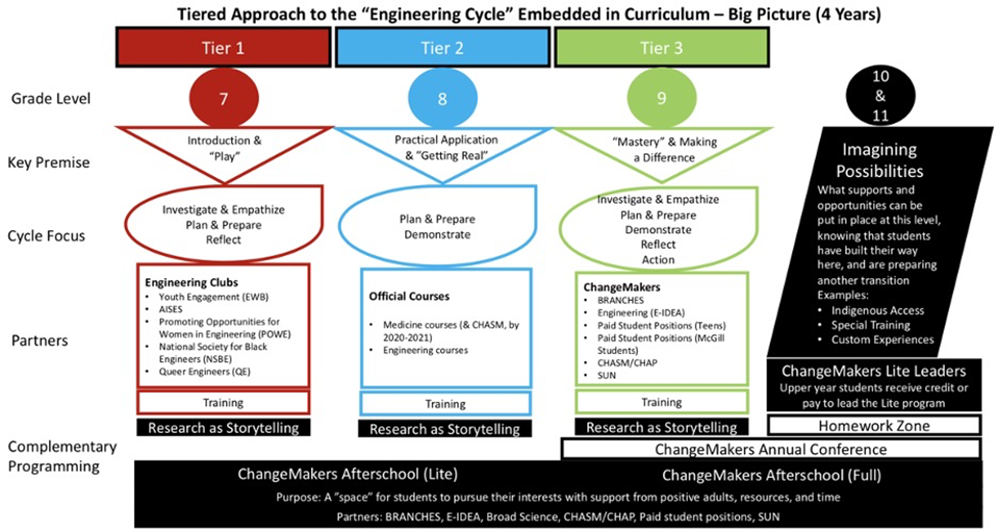


ChangeMakers is currently under development and is a collaboration between Branches, the Faculty of Engineering's E-IDEA program, other McGill units and partner schools in Kahnawá:ke and Verdun. The text below is excerpted from a funding application and if received, the goal is to launch a pilot version of the program during the 2021-22 academic year.
For more information, please contact Veronica Amberg.
“The future belongs to the curious. The ones who are not afraid to try it,
explore it, poke at it, question it, and turn it inside out.”
— Anonymous
We believe there is a need for ongoing, sustained relationship building and culturally relevant pedagogy to increase students’ access to —and success in— STEM fields (Ridgeway & Yerrick, 2018; Tan & Barton, 2010).
In order to draw underrepresented groups into STEM, young people must see how their real lives (cultures, languages, traditions, aspirations) relate to the tools and practices they engage with. To foster equity and diversity in STEM fields we believe there must be work done at all stages of the educational and career track, including relevant support for and cooperation with underrepresented communities.
Using Science Fair projects as an entry point to work with youth, ChangeMakers merges real-world, project-based learning with student-led inquiry in a multi-disciplinary and community-based context. Immersive learning experiences for students from grades 7 to 9, and mentoring opportunities for students in grades 10 & 11, will enable participants to engage with the engineering design cycle as one framework for identifying a ‘problem’ and finding ways to solve and explore it from a multi-disciplinary perspective.
In order to introduce students to a breadth of experiences and perspectives, participants work with university student volunteers in class and in after-school sessions, accompanied by team projects with adult mentors to explore and create with local and global contexts in mind.
We believe there are rich founts of knowledge residing within each child and a plethora of resources within our communities that can be offered as a complement to school practices and teaching approaches. ChangeMakers intends to act as a conduit for these community resources and youth perspectives to come together, share knowledge, and build and test solutions together. By creating a cooperative student-centered learning experience, youth receive the support they need to express their knowledge confidently. They are encouraged to solve problems, get a feel for science, and experience the pleasure of building something that can contribute to their communities.
We want to foster reciprocal and responsive partnerships through shared vision and communication, to encourage access to education for youth in need of additional support through experiential learning and mentorship;
We want to connect with youth through practices that relate to their identities, creating the space for students to teach and experts to learn when possible;
We aim to find ways for youth to understand the world and contribute to its improvement through design-oriented thinking and experiential learning;
We seek to dialogue with various traditions of science education and learn with a more respectful, patient, connected, and accepting pedagogical stance, to aim for an environment where a variety of discourse norms can be practiced;
We work to draw upon students’ sources of knowledge to engage them, while validating their personal experiences as an integral part of STEM learning (Gonsalves, 2014; Seiler, 2013);
We want to promote Citizen Science, providing means by which citizens can better their own community through the study of local environments, transformation and social change (Bang et al 2010)
The true self in everyone is good, wise, and powerful
The world is profoundly interconnected
All human beings have a deep desire to be in a good relationship
All human beings have gifts, and everyone is needed for what they bring
Everything we need to make positive change is already here
Human beings are holistic
We need practices to build habits of living from the core self
* Excerpted from Heart of Hope and Circle Forward, by Carolyn Boyes-Watson and Kay Pranis. 2010, Living Justice Press

Bang, M., Medin, D., Washinawatok, K., & Chapman, S. (2010). Innovations in culturally based science education through partnerships and community. In M. Khine & I. Saleh (Eds.), New science of learning: Cognition, computers and collaboration in education (pp. 569–592). New York: Springer.DOI:10.1007/978-1-4419-5716-0_28.
Gonsalves, A (2014). Persistent discourses in physics education: gender neutrality and the gendering of competence. Cult Stud of Sci Educ (2014) 9:461–467, DOI: 10.1007/s11422-012-9423-1
Ridgeway, M.L. & Yerrick, R.K. (2018). Whose banner are we waving? Exploring STEM
partnerships for marginalized urban youth. Cultural Studies of Science Education, 13:59–84, https://doi.org/10.1007/s11422-016-9773-1
Seiler, G (2013). Reconstructing Science Curricula Through Student Voice and Choice. Education and Urban Society 45(3) 362–384, DOI: 10.1177/0013124511408596
Tan, E. & Barton, A.C. (2010). Transforming Science Learning and Student Participation in Sixth Grade Science: A Case Study of a Low-Income, Urban, Racial Minority Classroom, Equity & Excellence in Education, 43:1, 38-55, DOI: 10.1080/10665680903472367
E-IDEA – Faculty of Engineering
National Sciences and Research Council of Canada